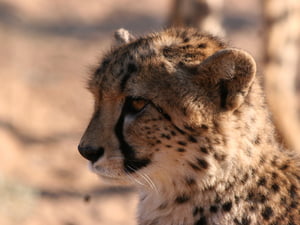Appearance
Cheetahs are 30 inches or tall at the shoulder, weigh about 70 to 140 pounds, are about 4 feet long and have an almost 30 inch long tail. The cheetah is somewhat different then other cats. Its body is leaner and its legs are longer. It has weak jaw and small teeth. The cheetah must rely on its speed to catch prey. The cheetah is able to run up to 70 mph but does not have the strength to protect its kills or it’s young from larger predators.
Cheetahs are tan of buff colored with small black spots. The cheetah is sometimes confused with a leopard however leopards have rosettes while cheetahs only have spots. The underbelly of the cheetah is free of spot sand is white. The spots on the tail merge together to become stripes. The tail has a bushy white tuft at the end in most cheetahs.
Behavior
Cheetahs become sexually mature at 20 to 24 months. A mating period lasts between 1 to 7 days and the female’s pregnancy lasts 90 to 95 days. The litter may contain up to 6 cubs. They are blind and helpless at birth, not opening their eyes until they are 4 to 10 days old, at which time they start crawling around the nest. When the cubs are very young the mother moves them every few days to avoid predators. She is unable to protect them most of the time during the first 6 weeks because she has to hunt for food. The death rate of cubs during this first 6 weeks is very high. After 6 weeks the cubs will begin to follow the mother to hunt.
Cheetahs hunt by stalking close to the prey and then breaking out into a sprint. They trip the animal using its front paw and then bite down on the neck of the animal. Cheetahs prey consists of rabbits to small antelope and occasionally the young of larger prey.
At 6 months cheetahs are full grown and at 8 months they have lost their baby teeth. At this time they begin to learn how to hunt. They will still not be overly proficient at hunting by the time their mother leaves them when they are between 16 and 18 months old. The sibling cubs will most often stay together for some time, until the females become sexually mature. Male cubs will stay together for life. They create a coalition which helps them to obtain and maintain territories against other male cheetahs.
Environment
Most consider the cheetah to be an animal of the grass lands. This is merely because the animal is easier to spot in the short grass. The cheetah actually is present in many other habitats including mountainous and dense vegetation.
Conservation Status
The cheetah is unlike most other endangered species. While they do suffer from habitat loss, human encroachment, trapping and killing these are not the only things that threaten the future of the species. Their own genetics are a problem. Their genetic variation is very low which can lead to birth defects and disease. Through studies it has also been found that male cheetahs have a very high amount of abnormal sperm: up to 70 percent. These abnormalities include sperms with two heads (bicephalic) and sperm with very large heads (macrocephalic). The theory is that these abnormalities stem from the low genetic variation in cheetahs. In short, the cheetahs own genetics is helping to wipe out the entire species.
There is still hope for the species. There is a cheetah species survival plan that was put into effect in 1988. This plan appointed the cheetah population of North America to be a research population. They are being studies very closely and there are several ongoing long term research projects in effect to determine how to save the cheetahs from extinction.


